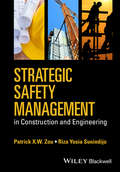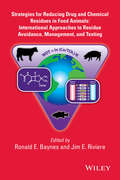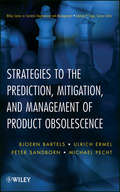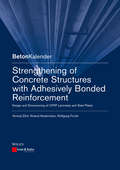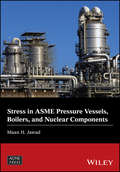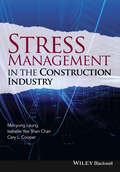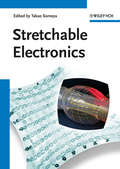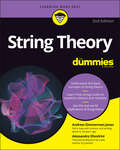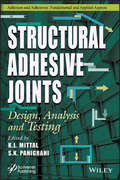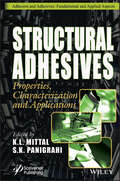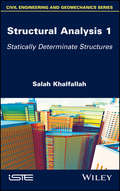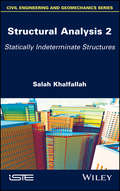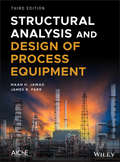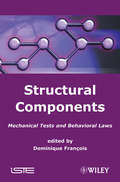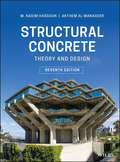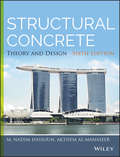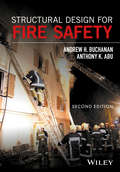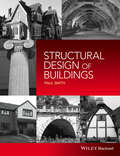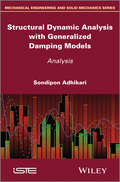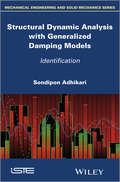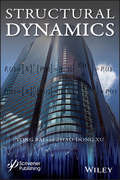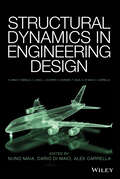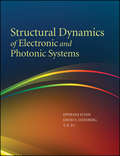- Table View
- List View
Strategic Safety Management in Construction and Engineering
by Patrick Zou Riza Yosia SunindijoAlthough the construction and engineering sector makes important contributions to the economic, social, and environmental objectives of a nation, it has a notorious reputation for being an unsafe industry in which to work. Despite the fact that safety performance in the industry has improved, injuries and fatalities still occur frequently. To address this, the industry needs to evolve further by integrating safety into all decision making processes. Strategic Safety Management in Construction and Engineering takes a broad view of safety from a strategic decision making and management perspective with a particular focus on the need to balance and integrate 'science' and 'art' when implementing safety management. The principles covered here include the economics of safety, safety climate and culture, skills for safety, safety training and learning, safety in design, risk management, building information modelling, and safety research methods and the research-practice nexus. They are integrated into a strategic safety management framework which comprises strategy development, implementation, and evaluation. Practical techniques are included to apply the principles in the context of the construction and engineering industry and projects. Case studies are also provided to demonstrate the localised context and applications of the principles and techniques in practice.
Strategies for Reducing Drug and Chemical Residues in Food Animals
by Jim E. Riviere Ronald E. BaynesHighlighting international approaches; the book details strategies to minimize contamination, residue monitoring programs, and classes of drugs and chemicals that pose contaminant risk in livestock. Focuses attention on drug and chemical residues in edible animal products Covers novel computational, statistical, and mathematical strategies for dealing with chemical exposures in food animals Details major drug classes used in food animal production and their residue risks Highlights efforts at harmonizing and the differences among areas like US, EU, Canada, Australia, South America, China, and Asia, where the issue of chemical exposures has significant impact on livestock products Ties veterinary clinical practice and the use of these drugs in food animals with regulatory standards and mitigation practices
Strategies to the Prediction, Mitigation and Management of Product Obsolescence (Wiley Series in Systems Engineering and Management #87)
by Bjoern Bartels Ulrich Ermel Peter Sandborn Michael G. PechtSupply chains for electronic products are primarily driven by consumer electronics. Every year new mobile phones, computers and gaming consoles are introduced, driving the continued applicability of Moore's law. The semiconductor manufacturing industry is highly dynamic and releases new, better and cheaper products day by day. But what happens to long-field life products like airplanes or ships, which need the same components for decades? How do electronic and also non-electronic systems that need to be manufactured and supported of decades manage to continue operation using parts that were available for a few years at most? This book attempts to answer these questions. This is the only book on the market that covers obsolescence forecasting methodologies, including forecasting tactics for hardware and software that enable cost-effective proactive product life-cycle management. This book describes how to implement a comprehensive obsolescence management system within diverse companies. Strategies to the Prediction, Mitigation and Management of Product Obsolescence is a must-have work for all professionals in product/project management, sustainment engineering and purchasing.
Stream Hydrology
by Christopher J. Gippel Rory J. Nathan Nancy D. Gordon Brian L. Finlayson Thomas A. McmahonSince the publication of the first edition (1994) there have been rapid developments in the application of hydrology, geomorphology and ecology to stream management. In particular, growth has occurred in the areas of stream rehabilitation and the evaluation of environmental flow needs. The concept of stream health has been adopted as a way of assessing stream resources and setting management goals.Stream Hydrology: An Introduction for Ecologists Second Edition documents recent research and practice in these areas. Chapters provide information on sampling, field techniques, stream analysis, the hydrodynamics of moving water, channel form, sediment transport and commonly used statistical methods such as flow duration and flood frequency analysis. Methods are presented from engineering hydrology, fluvial geomorphology and hydraulics with examples of their biological implications. This book demonstrates how these fields are linked and utilised in modern, scientific river management.Emphasis on applications, from collecting and analysing field measurements to using data and tools in stream management.Updated to include new sections on environmental flows, rehabilitation, measuring stream health and stream classification.Critical reviews of the successes and failures of implementation.Revised and updated windows-based AQUAPAK software.This book is essential reading for 2nd/3rd year undergraduates and postgraduates of hydrology, stream ecology and fisheries science in Departments of Physical Geography, Biology, Environmental Science, Landscape Ecology, Environmental Engineering and Limnology. It would be valuable reading for professionals working in stream ecology, fisheries science and habitat management, environmental consultants and engineers.
Streamlining Digital Signal Processing
by Richard G. LyonsThis book presents recent advances in DSP to simplify, or increase the computational speed of, common signal processing operations. The topics describe clever DSP tricks of the trade not covered in conventional DSP textbooks. This material is practical, real-world, DSP tips and tricks as opposed to the traditional highly-specialized, math-intensive, research subjects directed at industry researchers and university professors. This book goes well beyond the standard DSP fundamentals textbook and presents new, but tried-and-true, clever implementations of digital filter design, spectrum analysis, signal generation, high-speed function approximation, and various other DSP functions.
Strengthening of Concrete Structures with Adhesively Bonded Reinforcement: Design and Dimensioning of CFRP Laminates and Steel Plates
by Konrad Zilch Roland Niedermeier Wolfgang FinckhDesign and construction in existing contexts is becoming increasingly important, and often the structures - sometimes of historical interest - can be preserved easily and at minimum cost by employing strengthening measures. Existing concrete members can be strengthened by using adhesives to bond additional reinforcing elements onto or into those members. This book explains the design rules, together with their background, and uses examples to illustrate their use, specifically for slabs, beams and columns. Concrete member strengthening measures can take the form of, for example, flexural strengthening with externally bonded (surface-mounted) CFRP strips, CF sheets and steel plates, flexural strengthening with CFRP strips bonded in slits (near-surface-mounted reinforcement), shear strengthening with externally bonded CF sheets and steel plates, and column strengthening with CF sheets as confining reinforcement. The explanations and background information provided are mainly based on the new German guideline "Strengthening of Concrete Members with Adhesively Bonded Reinforcement" by the German Committee for Structural Concrete (DAfStb). This is the first European guideline to regulate this topic in the form of a supplement to the Eurocode. As it is planned to produce a document in a future Eurocode 2, the DAfStb guideline serves as a starting point. The authors are extensively involved in the planning, design, operation and inspection of buildings for preservation and reconstruction, and in the updating of European Technical Approval Guidelines (ETAGs) and design rules. Selected chapters from the German concrete yearbook are now being published in the new English "Beton-Kalender Series" for the benefit of an international audience. Since it was founded in 1906, the Ernst & Sohn "Beton-Kalender" has been supporting developments in reinforced and prestressed concrete. The aim was to publish a yearbook to reflect progress in "ferro-concrete" structures until - as the book's first editor, Fritz von Emperger (1862-1942), expressed it - the "tempestuous development" in this form of construction came to an end. However, the "Beton-Kalender" quickly became the chosen work of reference for civil and structural engineers, and apart from the years 1945-1950 has been published annually ever since.
Stress in ASME Pressure Vessels, Boilers, and Nuclear Components
by Maan H. JawadAn illustrative guide to the analysis needed to achieve a safe design in ASME Pressure Vessels, Boilers, and Nuclear Components Stress in ASME Pressure Vessels, Boilers, and Nuclear Components offers a revised and updatededition of the text, Design of Plate and Shell Structures. This important resource offers engineers and students a text that covers the complexities involved in stress loads and design of plates and shell components in compliance with pressure vessel, boiler, and nuclear standards. The author covers the basic theories and includes a wealth of illustrative examples for the design of components that address the internal and external loads as well as other loads such as wind and dead loads. The text keeps the various derivations relatively simple and the resulting equations are revised to a level so that they can be applied directly to real-world design problems. The many examples clearly show the level of analysis needed to achieve a safe design based on a given required degree of accuracy. Written to be both authoritative and accessible, this important updated book: Offers an increased focus on mechanical engineering and contains more specific and practical code-related guidelines Includes problems and solutions for course and professional training use Examines the basic aspects of relevant theories and gives examples for the design of components Contains various derivations that are kept relatively simple so that they can be applied directly to design problems Written for professional mechanical engineers and students, this text offers a resource to the theories and applications that are needed to achieve an understanding of stress loads and design of plates and shell components in compliance with pressure vessel, boiler, and nuclear standards.
Stress Management in the Construction Industry
by Mei-yung Leung Isabelle Yee Chan Cary CooperThis systematic review of stress management in construction will help an understanding of the issues and theory as well as offering practical recommendations. addresses the growing concern to make work in construction healthier, safer, and more productive integrates research results, survey statistics and scenario analyses to reveal underlying causes of stress offers recommendations for reducing Stress
Stretchable Electronics
by Takao SomeyaOn a daily basis, our requirements for technology become more innovative and creative and the field of electronics is helping to lead theway to more advanced appliances. This book gathers and evaluates the materials, designs, models, and technologies that enable the fabrication of fully elastic electronic devices that can tolerate high strain. Written by some of the most outstanding scientists in the field, it lays down the undisputed knowledge on how to make electronics withstand stretching. This monograph provides a review of the specific applications that directly benefit from highly compliant electronics, including transistors, photonic devices, and sensors. In addition to stretchable devices, the topic of ultraflexible electronics is treated, highlighting its upcoming significance for the industrial-scale production of electronic goods for the consumer.Divided into four parts covering:* Theory* Materials and Processes* Circuit Boards* Devices and ApplicationsAn unprecedented overview of this thriving area of research that nobody in the field - or intending to enter it - can afford to miss.
String Theory For Dummies
by Andrew Zimmerman Jones Alessandro SfondriniUnravel the secrets of the universe and untangle cutting-edge physics Yes, you actually can understand quantum physics! String Theory For Dummies is a beginner’s guide, and we make it fun to find out about the all the recent trends and theories in physics, including the basics of string theory, with friendly explanations. Build a foundation of physics knowledge, understand the various string theories and the math behind them, and hear what the opponents to string theory have to say. It’s an exciting time to be alive in advanced physics, and this updated edition covers what’s new in the string world—the Large Hadron Collider, the Higgs Boson, gravitational waves, and lots of other big headlines. Unleash your inner armchair physicist with String Theory For Dummies. Brush up on the basics of physics and the approachable math needed to understand string theory Meet the scientists who discovered string theory and continue to make waves (and particles) in the physics world Understand what it’s all about with real-world examples and explanations Learn why string theory is called "The Theory of Everything"—and what it means for technology and the future Aspiring scientists or life-long learners will both be able to gain valuable information from this book. This accessible intro into string theory is for the theorists inside anyone.
Structural Adhesive Joints: Design, Analysis, and Testing
by K. L. Mittal S. K. PanigrahiMost structures are comprised of a number of individual parts or components which have to be connected to form a system with integral load transmission path. The structural adhesive bonding represents one of the most enabling technologies to fabricate most complex structural configurations involving advanced materials (e.g. composites) for load-bearing applications. Quite recently there has been a lot of activity in harnessing nanotechnology (use of nanomaterials) in ameliorating the existing or devising better performing structural adhesives. The 10 chapters by subject matter experts look at the following issues: Surface preparation for structural adhesive joints (SAJ) Use of nanoparticles in enhancing performance of SAJ Optimization of SAJ Durability aspects of SAJ Debonding of SAJ Fracture mechanics of SAJ Failure analysis of SAJ Damage behavior in functionally graded SAJ Impact, shock and vibration characteristics of composites for SAJ Delamination arrest methods in SAJ
Structural Adhesives: Properties, Characterization and Applications
by K. L. Mittal S. K. PanigrahiStructural Adhesives Uniquely provides up-to-date and comprehensive information on the topic in an easily-accessible form. A structural adhesive can be described as a high-strength adhesive material that is isotropic in nature and bonds two or more parts together in a load-bearing structure. A structural adhesive material must be capable of transmitting the stress/load without loss of structural integrity within design limits. There are many types of established structural adhesives, including epoxy, urethane, acrylic, silicone, etc. Structural Adhesives comprises nine chapters and is divided into two parts: Part 1, Preparation, Properties, and Characterization; Part 2, Applications. The topics covered include: structural epoxy adhesives; biological reinforcement of epoxies as structural adhesives; marble dust reinforced epoxy structural adhesive composites; characterization of various structural adhesive materials; effects of shear and peel stress distributions on the behavior of structural adhesives; the inelastic response of structural aerospace adhesives; structural reactive acrylic adhesives: their preparation, characterization, properties, and applications; application of structural adhesives in composite connections; and naval applications of structural adhesives. Audience This book should be of much use and interest to adhesionists, materials scientists, adhesive technologists, polymer scientists, and those working in the construction, railway, automotive, aviation, bridge, and shipbuilding industries.
Structural Analysis 1: Statically Determinate Structures
by Salah KhalfallahUsing a general approach, this book supports the student to enable mastery of the methods of analysis of isostatic and hyperstatic structures. To show the performance of the methods of analysis of the hyperstatic structures, selected beams, gantries and reticular structures are selected and subjected to a comparative study by the different methods of analysis of the hyperstatic structures.
Structural Analysis 2: Statically Indeterminate Structures
by Salah KhalfallahThis book enables the student to master the methods of analysis of isostatic and hyperstatic structures. To show the performance of the methods of analysis of the hyperstatic structures, some beams, gantries and reticular structures are selected and subjected to a comparative study by the different methods of analysis of the hyperstatic structures. This procedure provides an insight into the methods of analysis of the structures.
Structural Analysis and Design of Process Equipment
by Maan H. Jawad James R. FarrStill the only book offering comprehensive coverage of the analysis and design of both API equipment and ASME pressure vessels This edition of the classic guide to the analysis and design of process equipment has been thoroughly updated to reflect current practices as well as the latest ASME Codes and API standards. In addition to covering the code requirements governing the design of process equipment, the book supplies structural, mechanical, and chemical engineers with expert guidance to the analysis and design of storage tanks, pressure vessels, boilers, heat exchangers, and related process equipment and its associated external and internal components. The use of process equipment, such as storage tanks, pressure vessels, and heat exchangers has expanded considerably over the last few decades in both the petroleum and chemical industries. The extremely high pressures and temperatures involved with the processes for which the equipment is designed makes it potentially very dangerous to property and life if the equipment is not designed and manufactured to an exacting standard. Accordingly, codes and standards such as the ASME and API were written to assure safety. Still the only guide covering the design of both API equipment and ASME pressure vessels, Structural Analysis and Design of Process Equipment, 3rd Edition: Covers the design of rectangular vessels with various side thicknesses and updated equations for the design of heat exchangers Now includes numerical vibration analysis needed for earthquake evaluation Relates the requirements of the ASME codes to international standards Describes, in detail, the background and assumptions made in deriving many design equations underpinning the ASME and API standards Includes methods for designing components that are not covered in either the API or ASME, including ring girders, leg supports, and internal components Contains procedures for calculating thermal stresses and discontinuity analysis of various components Structural Analysis and Design of Process Equipment, 3rd Edition is an indispensable tool-of-the-trade for mechanical engineers and chemical engineers working in the petroleum and chemical industries, manufacturing, as well as plant engineers in need of a reference for process equipment in power plants, petrochemical facilities, and nuclear facilities.
Structural Components: Mechanical Tests and Behavioral Laws
by Dominique FranÇoisThe mechanical tests presented in this book are essential for determining the basic properties of the materials used. Areas covered include elasticity, tensile and compression tests, hardness, endurance tests and dynamic tests.
Structural Concrete: Theory and Design
by M. Nadim Hassoun Akthem Al-ManaseerThe leading structural concrete design reference for over two decades—updated to reflect the latest ACI 318-19 code A go-to resource for structural engineering students and professionals for over twenty years, this newly updated text on concrete structural design and analysis reflects the most recent ACI 318-19 code. It emphasizes student comprehension by presenting design methods alongside relevant codes and standards. It also offers numerous examples (presented using SI units and US-SI conversion factors) and practice problems to guide students through the analysis and design of each type of structural member. New to Structural Concrete: Theory and Design, Seventh Edition are code provisions for transverse reinforcement and shear in wide beams, hanger reinforcement, and bi-directional interaction of one-way shear. This edition also includes the latest information on two-way shear strength, ordinary walls, seismic loads, reinforcement detailing and analysis, and materials requirements. This book covers the historical background of structural concrete; advantages and disadvantages; codes and practice; and design philosophy and concepts. It then launches into a discussion of the properties of reinforced concrete, and continues with chapters on flexural analysis and design; deflection and control of cracking; development length of reinforcing bars; designing with the strut-and-tie method; one-way slabs; axially loaded columns; and more. Updated to align with the new ACI 318-19 code with new code provisions to include: transverse reinforcement and shear in wide beams, hanger reinforcement, bi-directional interaction of one-way shear, and reference to ACI certifications Includes dozens of worked examples that explain the analysis and design of structural members Offers updated information on two-way shear strength, seismic loads, materials requirements, and more Improves the design ability of students by explaining code requirements and restrictions Provides examples in SI units in every chapter as well as conversion factors from customary units to SI Offers instructors access to a solutions manual via the book's companion website Structural Concrete: Theory and Design, Seventh Edition is an excellent text for undergraduate and graduate students in civil and structural engineering programs. It will also benefit concrete designers, structural engineers, and civil engineers focused on structures.
Structural Concrete: Theory and Design
by M. Nadim Hassoun Akthem Al-ManaseerThe most up to date structural concrete text, with the latest ACI revisions Structural Concrete is the bestselling text on concrete structural design and analysis, providing the latest information and clear explanation in an easy to understand style. Newly updated to reflect the latest ACI 318-14 code, this sixth edition emphasizes a conceptual understanding of the subject, and builds the student's body of knowledge by presenting design methods alongside relevant standards and code. Numerous examples and practice problems help readers grasp the real-world application of the industry's best practices, with explanations and insight on the extensive ACI revision. Each chapter features examples using SI units and US-SI conversion factors, and SI unit design tables are included for reference. Exceptional weather-resistance and stability make concrete a preferred construction material for most parts of the world. For civil and structural engineering applications, rebar and steel beams are generally added during casting to provide additional support. Pre-cast concrete is becoming increasingly common, allowing better quality control, the use of special admixtures, and the production of innovative shapes that would be too complex to construct on site. This book provides complete guidance toward all aspects of reinforced concrete design, including the ACI revisions that address these new practices. Review the properties of reinforced concrete, with models for shrink and creep Understand shear, diagonal tension, axial loading, and torsion Learn planning considerations for reinforced beams and strut and tie Design retaining walls, footings, slender columns, stairs, and more The American Concrete Institute updates structural concrete code approximately every three years, and it's critical that students learn the most recent standards and best practices. Structural Concrete provides the most up to date information, with intuitive explanation and detailed guidance.
Structural Design for Fire Safety
by Andrew H. Buchanan Anthony Kwabena AbuStructural Design for Fire Safety, 2nd edition Andrew H. Buchanan, University of Canterbury, New Zealand Anthony K. Abu, University of Canterbury, New Zealand A practical and informative guide to structural fire engineering This book presents a comprehensive overview of structural fire engineering. An update on the first edition, the book describes new developments in the past ten years, including advanced calculation methods and computer programs. Further additions include: calculation methods for membrane action in floor slabs exposed to fires; a chapter on composite steel-concrete construction; and case studies of structural collapses. The book begins with an introduction to fire safety in buildings, from fire growth and development to the devastating effects of severe fires on large building structures. Methods of calculating fire severity and fire resistance are then described in detail, together with both simple and advanced methods for assessing and designing for structural fire safety in buildings constructed from structural steel, reinforced concrete, or structural timber. Structural Design for Fire Safety, 2nd edition bridges the information gap between fire safety engineers, structural engineers and building officials, and it will be useful for many others including architects, code writers, building designers, and firefighters. Key features: • Updated references to current research, as well as new end-of-chapter questions and worked examples. •Authors experienced in teaching, researching, and applying structural fire engineering in real buildings. • A focus on basic principles rather than specific building code requirements, for an international audience. An essential guide for structural engineers who wish to improve their understanding of buildings exposed to severe fires and an ideal textbook for introductory or advanced courses in structural fire engineering.
Structural Design of Buildings
by Paul SmithCovering common problems, likely failures and their remedies, this is an essential on-site guide to the behaviourof a building's structure. Presented in a clear structure and user-friendly style, the book goes through all the structural aspects of a building and assesses the importance of the different components. It explains the structural behaviour of buildings, giving some of the basics of structures together with plenty of real-life examples and guidance.
Structural Dynamic Analysis with Generalized Damping Models: Analysis (Wiley-iste Ser.)
by Sondipon AdhikariSince Lord Rayleigh introduced the idea of viscous damping in his classic work "The Theory of Sound" in 1877, it has become standard practice to use this approach in dynamics, covering a wide range of applications from aerospace to civil engineering. However, in the majority of practical cases this approach is adopted more for mathematical convenience than for modeling the physics of vibration damping. Over the past decade, extensive research has been undertaken on more general "non-viscous" damping models and vibration of non-viscously damped systems. This book, along with a related book Structural Dynamic Analysis with Generalized Damping Models: Identification, is the first comprehensive study to cover vibration problems with general non-viscous damping. The author draws on his considerable research experience to produce a text covering: dynamics of viscously damped systems; non-viscously damped single- and multi-degree of freedom systems; linear systems with non-local and non-viscous damping; reduced computational methods for damped systems; and finally a method for dealing with general asymmetric systems. The book is written from a vibration theory standpoint, with numerous worked examples which are relevant across a wide range of mechanical, aerospace and structural engineering applications. Contents 1. Introduction to Damping Models and Analysis Methods.2. Dynamics of Undamped and Viscously Damped Systems.3. Non-Viscously Damped Single-Degree-of-Freedom Systems.4. Non-viscously Damped Multiple-Degree-of-Freedom Systems.5. Linear Systems with General Non-Viscous Damping.6. Reduced Computational Methods for Damped Systems
Structural Dynamic Analysis with Generalized Damping Models: Identification (Wiley-iste Ser.)
by Sondipon AdhikariSince Lord Rayleigh introduced the idea of viscous damping in his classic work "The Theory of Sound" in 1877, it has become standard practice to use this approach in dynamics, covering a wide range of applications from aerospace to civil engineering. However, in the majority of practical cases this approach is adopted more for mathematical convenience than for modeling the physics of vibration damping. Over the past decade, extensive research has been undertaken on more general “non-viscous” damping models and vibration of non-viscously damped systems. This book, along with a related book Structural Dynamic Analysis with Generalized Damping Models: Analysis, is the first comprehensive study to cover vibration problems with general non-viscous damping. The author draws on his considerable research experience to produce a text covering: parametric senistivity of damped systems; identification of viscous damping; identification of non-viscous damping; and some tools for the quanitification of damping. The book is written from a vibration theory standpoint, with numerous worked examples which are relevant across a wide range of mechanical, aerospace and structural engineering applications. Contents 1. Parametric Sensitivity of Damped Systems. 2. Identification of Viscous Damping. 3. Identification of Non-viscous Damping. 4. Quantification of Damping. About the Authors Sondipon Adhikari is Chair Professor of Aerospace Engineering at Swansea University, Wales. His wide-ranging and multi-disciplinary research interests include uncertainty quantification in computational mechanics, bio- and nanomechanics, dynamics of complex systems, inverse problems for linear and nonlinear dynamics, and renewable energy. He is a technical reviewer of 97 international journals, 18 conferences and 13 funding bodies.He has written over 180 refereed journal papers, 120 refereed conference papers and has authored or co-authored 15 book chapters.
Structural Dynamics
by Yong BaiAcross many disciplines of engineering, dynamic problems of structures are a primary concern. Civil engineers, mechanical engineers, aircraft engineers, ocean engineers, and engineering students encounter these problems every day, and it is up to them systematically to grasp the basic concepts, calculation principles and calculation methods of structural dynamics. This book focuses on the basic theories and concepts, as well as the application and background of theories and concepts in engineering. Since the basic principles and methods of dynamics are applied to other various engineering fields, this book can also be used as a reference for practicing engineers in the field across many multiple disciplines and for undergraduate and graduate students in other majors as well. The main contents include basic theory of dynamics, establishment of equation of motion, single degree of freedom systems, multi-degree of freedom systems, distributed-parameter systems, stochastic structural vibrations, research projects of structural dynamics, and structural dynamics of marine pipeline and risers. Whether for the veteran engineer or student, this is a must-have for any scientific or engineering library.
Structural Dynamics in Engineering Design
by Nuno M. M. Maia Dario Di Maio Alex Carrella Francesco Marulo Chaoping Zang Jonathan E. Cooper Keith Worden Tiago A. N. SilvaWorld-class authors describe and illustrate how structural dynamics is applied to the engineering design process Structural Dynamics in Engineering Design covers the fundamentals of structural dynamics and its application to the engineering design process, providing all of the necessary information to implement an optimal design process. Each of its seven chapters is written by an expert in the field and provides the reader with the structural dynamic theoretical background and its more practical aspects for the implementation of an advanced design capability. The first three chapters are dedicated to the underlying theory of the three main processes: the fundamentals of vibration theory, the basis of experimental dynamics and the main numerical analysis tools (including reference to the finite element method). Having laid the foundation of the design philosophy, the following three chapters present the reader with the three disciplines of identification, nonlinear analysis and validation/updating. The final chapter presents some applications of the approach to real and complex engineering cases. Key features: Takes a multi-disciplinary approach and contains critical information on theory, testing and numerical analysis for structural dynamics. Includes a chapter on industrial applications (including aircraft design and ground vibration testing), which illustrates the design process and explains how structural dynamics is applied at different stages. The book is a must-have for researchers and practitioners in mechanical and aerospace engineering (in particular test engineers, CAE analysts and structural dynamicists), as well as graduate students in mechanical and aerospace engineering departments.
Structural Dynamics of Electronic and Photonic Systems
by Ephraim Suhir T. X. Yu David S. SteinbergThe proposed book will offer comprehensive and versatile methodologies and recommendations on how to determine dynamic characteristics of typical micro- and opto-electronic structural elements (printed circuit boards, solder joints, heavy devices, etc.) and how to design a viable and reliable structure that would be able to withstand high-level dynamic loading. Particular attention will be given to portable devices and systems designed for operation in harsh environments (such as automotive, aerospace, military, etc.) In-depth discussion from a mechanical engineer's viewpoint will be conducted to the key components' level as well as the whole device level. Both theoretical (analytical and computer-aided) and experimental methods of analysis will be addressed. The authors will identify how the failure control parameters (e.g. displacement, strain and stress) of the vulnerable components may be affected by the external vibration or shock loading, as well as by the internal parameters of the infrastructure of the device. Guidelines for material selection, effective protection and test methods will be developed for engineering practice.
